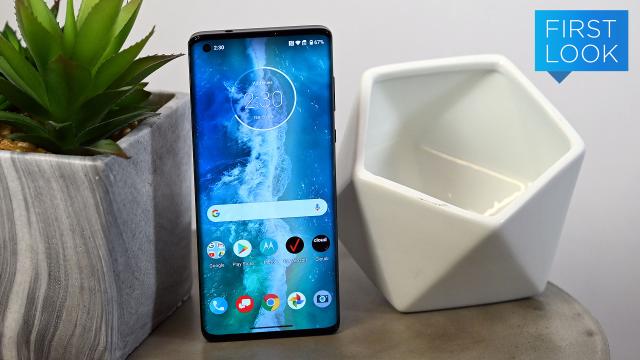It’s been almost three years since Motorola released anything you could really consider a flagship phone (and that’s including its $2,699 bendy-screen Razr reboot). But now with the new Edge+, Motorola is getting back in the high-end handset game with practically all the features people expect in a premium device, for a somewhat reasonable price.
It’s almost as if Motorola used Samsung’s Galaxy S20+ as a template, but then started tweaking things to add a bit of excitement (while also trying to accommodate customer feedback). So instead of the almost flat screen on the S20+ that features just a hint of a curve, Motorola has gone for an extremely curvy wraparound screen on the Edge+, which features a 6.7-inch FHD+ OLED “Endless Edge” display that comes with a good, but not class-leading 90Hz refresh rate.
Not only does this cause the phone’s home screen to bend around the sides of the phone, Moto will also light up the sides of the Edge+’s display for things like notifications or during charging. Meanwhile, that 90Hz refresh rate should result in smoother-looking gaming and more fluid animations when flipping between apps and settings.
For gamers, the Edge+’s 3D display comes with another bonus. You can use the edge’s of its display as virtual buttons, adding an extra level of control and customizability to mobile shooters like Fortnite, COD, or PUBG.
It’s a neat effect and the Edge+ is one of the few phones that will officially be available in the U.S. and that’s jumping on the waterfall display trend that has become somewhat popular on high-end Chinese phones like Huawei Mate 30 Pro and Oppo Find X2 Pro. However, for everyone out there who might not appreciate the Edge+’s curvy screen, thankfully there is an option to disable the wrap-around effect, limiting visuals strictly to the front of the phone.
As for its cameras, the Edge+ is taking a page out of the Galaxy S20 Ultra’s playbook with the inclusion of a 108-MP main sensor which allows you to shoot full-resolution shots when you want to see every last pixel of detail. However, by default it uses pixel-binning to produce more manageable 27-MP photos. Moto claims this main sensor produces nearly pro-level DSLR quality photos and videos, which is something we’ve heard countless smartphone makers say before (and fail to deliver), so I’m definitely curious to see if the Edge+’s camera can live up to the hype.
Aside from the main cam, the Edge+ also comes with a solid assortment of supplementary cameras for a high-end phone including an 8-MP telephoto cam with a 3x optical zoom, a 16-MP ultra-wide angle cam, and even a dedicated Macro Vision setting. When it comes to video, the Edge+ also features a hybrid stabilisation system that combines both optical and electronic stabilisation to create smoother-looking clips, and even 6K video recording (but not 8K like you get on the S20 line).
On the inside, the Edge+ easily lives up to its high-end aspirations, sporting a Qualcomm Snapdragon 865 processor, 12GB of RAM, 256GB of base storage, a sizable 5,000 mAh battery, and support for both mmWave and sub-6GHz 5G. And while the Edge+ doesn’t have a microSD card slot, it does have an honest-to-goodness headphone jack—a feature that has become a rarity among premium handsets. In fact, one of the only other new high-end phones in recent memory to also get a 3.5mm jack is the LG V60.
Moto has even taken measures to improve the Edge+’s charging, offering support for 18-watt TurboPower wired charging, 15-watt Qi wireless charging, and 5-watt reverse wireless charging in case you ever need to help out a friend with a phone that’s low on juice.
But what might be the best thing about the Edge+ is its price, because at $US1,000 ($1,588), the Edge+ offers almost everything you get from a Galaxy S20+, but for $US200 ($318) less.
Editor’s note: Motorola hasn’t announced how much the Edge+ will be in Australia, when it will be released here or if the specs differ from international versions. The U.S. prices provide a rough indication.
The main differences are that instead of Samsung’s 120Hz refresh rate display and microSD card slot, the Edge+ has a screen that tops out at 90Hz, a higher resolution main cam, and a headphone jack. And in a somewhat strange turn of events, the Edge+ is arguably the more stylish of the two, though it’s selection of colours (purple and grey) could use some work.
Moto says the Edge+ will be available as an unlocked device in other countries, but it’s unclear if Edge+ devices purchased internationally and brought to the U.S. will have functional 5G connectivity. In the U.S., it’s a Verizon exclusive.
Finally, in case the Edge+ is a bit too rich for you, there will also be a more affordable standard Edge with a slightly less speedy Snapdragon 765 chip, 4GB of RAM, 128GB of storage, a headphone jack, microSD card slot, and lower-res 64-MP camera. Unfortunately, Motorola hasn’t announced pricing or availability for the vanilla Edge, so it’s hard to say yet how much a deal the Edge+’s more humble sibling will be.
